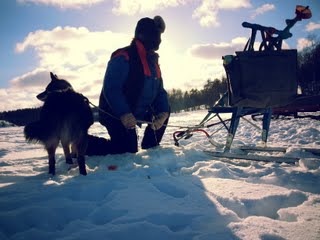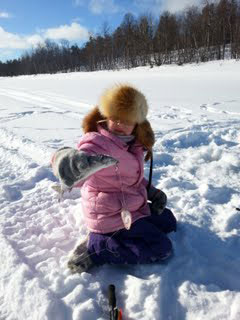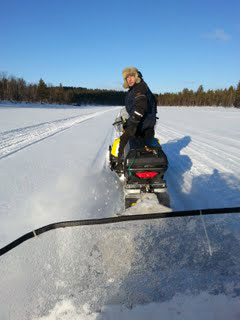I am a passionate fisherwoman as many of the people in Lapland are. I cannot point to any single reason for this passion but I can evaluate the main importance of this activity. Before getting in to the arts of fishing I want to pinpoint that my life with fish (and reindeer) as a whole conducts the basics in my thinking and writing anthropology – e.g. concepts of enskilment and tacit knowledge. Here I talk about my personal knowledge, from the special locality of the upper stream of Ivalo River.
 Fishing is a very social happening among families and friends. We have ice-fishing competitions, and they are very popular. The highlight for children is to catch fish, some are more in it and the others just enjoy frying the sausage/meat by the fire. By doing fishing the children learn to be patient, they learn to rely in their hand, line, the hook. If having a catch, they learn about different types of fish, when to release it or when to kill it.
Fishing is a very social happening among families and friends. We have ice-fishing competitions, and they are very popular. The highlight for children is to catch fish, some are more in it and the others just enjoy frying the sausage/meat by the fire. By doing fishing the children learn to be patient, they learn to rely in their hand, line, the hook. If having a catch, they learn about different types of fish, when to release it or when to kill it.
Somehow I have learned to know the weather and its connection to a good catch, it is in my bones. If the weather changes, e.g. it becomes warmer, the north wind finishes or it is a gentle snow fall, I became nerves and I need to get out to fish. The moods and movements of fish are connected e.g. to light, warmth, water level, ice/snow thickness, the moon, spawning time and daily hrs. It is just the same than it is with berries; different summers with warmth and rain/draught make especially blue berries and cloud berries to grow in different places. This is rather experience based knowledge, one somehow just knows there things.
 When I fish, I have learned to think like a different type of fish think, mainly I know about salmon trout, brown trout, pike, grayling, perch and burbot. Trout is a wise fish, it is aggressive, but sensible, if it does not come to the hook in the first try, it swims away and thinks:” You stupid human being, do you think you can beat me?” If a big trout or a big pike takes the bite on a hook, it is a normally a very exiting situation. One has to be careful in making it tired, usually, I do not have an extreme strong line, and in these cases I need to make the fish tired before picking it up. Grayling is a fish with strong interest in worms. Even if the hook comes out and it is corrected, grayling comes back. I think it gets so fascinated in the movements of the lure and worm. One of the interesting part in fishing is the game with fish. There are times when fish is not hungry. They know, however, how to play, they take a hold on the hook/worm gently and swim with it under the ice – in a way they are playing with the fisher. In each case, you listen to (kuunnella) the line with your hand and you talk with fish by moving your hand and the line.
When I fish, I have learned to think like a different type of fish think, mainly I know about salmon trout, brown trout, pike, grayling, perch and burbot. Trout is a wise fish, it is aggressive, but sensible, if it does not come to the hook in the first try, it swims away and thinks:” You stupid human being, do you think you can beat me?” If a big trout or a big pike takes the bite on a hook, it is a normally a very exiting situation. One has to be careful in making it tired, usually, I do not have an extreme strong line, and in these cases I need to make the fish tired before picking it up. Grayling is a fish with strong interest in worms. Even if the hook comes out and it is corrected, grayling comes back. I think it gets so fascinated in the movements of the lure and worm. One of the interesting part in fishing is the game with fish. There are times when fish is not hungry. They know, however, how to play, they take a hold on the hook/worm gently and swim with it under the ice – in a way they are playing with the fisher. In each case, you listen to (kuunnella) the line with your hand and you talk with fish by moving your hand and the line.
Moving along on ice is the part of my life. Each year I learn more about ice because every year there are different types of weather making its own ice construction. During this year we have special ice again – the first autumn ice was good steal ice (black ice), however, long warmth in the early winter made ice to break just like during spring time constructing back ice in the middle rapids and streams. Beside the blocks of ice the wind backed snow prevented the river to freeze and there can be dangerous wholes under snow. Normally the first open water is by the shores. Shores became open already few month before the normal time. And again they can be holes under the backed snow covers made by the spring snow storms. Once I drill the ice I feel the different structures and
 levels of ice, again this knowledge is in my hands, I just “listen to the ice”. I just know how the ice will melt in different places during the coming months.
levels of ice, again this knowledge is in my hands, I just “listen to the ice”. I just know how the ice will melt in different places during the coming months.
The people with the heat in ice-fishing might take high risks because they rely in their good experience in ice construction. The most dangerous time is in late spring, when there is quite a lot of open water, because the best catch comes near open water. One has to remind herself not to get too excited with the thin ice.
Fishing is a part of outside life, the other part is about going along. To be social is not only being social with human beings but with all the fellows that are there. As the spring proceeds there are different birds and signings, Siberian jays can come to eat the same food as well as the curious foxes come to the same places after our departure. The game moves around me in the woods, I know it with the help of my dog´s sense of hearing, and smell, she indicates me things I cannot see or hear. The other part of sociability is the knowledge of tracks, changes in winds etc. This becomes automatic, I just know it – once coming home, I can tell my husband what I have seen, who has been around. This is very social life in the wilderness though I may not see any human being. Finally, we eat fish, once I come home and I cook a dinner for us, is a part of enjoyment of life, the CR-fishing is familiar only if the fish is too small.
Text by Terhi Vuojala-Magga
Photos by Katariina Kurttila